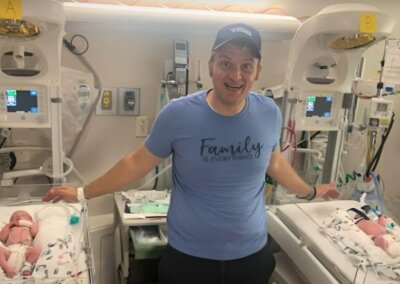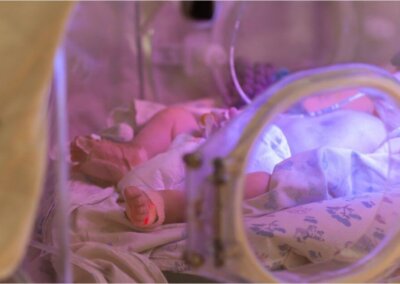A little girl who was born three months prematurely, weighing only 1.1 lbs and with an extremely narrow airway, has finally been able to have her tracheostomy tube removed at the age of four.
Safaa Cardello was born around the time the COVID-19 pandemic began in March 2020, and she was so premature she had to be taken into a Neonatal Intensive Care Unit (NICU).
Safaa’s father, Adam Cardello said “Shortly after Safaa was born, pandemic lockdowns were implemented and only one visitor was allowed in the hospital at a time, so we had to take turns visiting her in the NICU”.
“We were not only scared of getting germs at the hospital, but we were scared of bringing germs into the hospital and harming Safaa”.
Safaa experienced problems with her breathing early on
In addition to bronchopulmonary dysplasia, or premature lung disease, caused by her lungs not being fully developed in the womb, Safaa had an extremely narrow upper airway, which made it difficult for her to breathe without medical aid.
Irina Dralyuk, a paediatric pulmonologist at the hospital, said “I would honestly say Safaa had the smallest windpipe I’ve ever seen”.
In order to bypass her narrow airway, Safaa was given a tracheostomy, which creates an opening in the neck that makes breathing easier. She was discharged from the NICU four months later, but still had the tracheostomy tube to help with her breathing.
“When I first met Safaa, her airway opening was only a couple of millimetres wide”, said Dr Gene Liu, a pediatric ear, nose and throat specialist at the hospital. “And even though she was growing, her windpipe needed help to expand”.
Safaa’s parents and her medical team decided to use a balloon dilation strategy to widen Safaa’s airway.
“Every few months, we would look at Safaa’s airway with a fiberoptic camera, and the balloon dilation procedure would gently push open the airway little by little until it became a very nice, normal-looking airway”, Dr Liu said.
The tracheostomy tube was finally removed soon after Safaa’s fourth birthday.
Safaa and family became close to their medical team
“Safaa got to know us really well and I think that helped when she would come in for her balloon dilation”, Dr Dralyuk said. “I would always meet her and her family in pre-op and either Dr Liu or I would carry her back to the procedure area. She’s a tough cookie. She and her parents have done an amazing job”.
“Early on, we didn’t know what Safaa’s voice might sound like due to her narrow airway and whether there may be any residual damage to her vocal cords”, the doctor added. “Now when I see her, and I hear, ‘Hi Dr Dralyuk,’ it is really special”.
Safaa’s mother Zohra expressed her gratitude for the medical care they received.
“The advice Drs Liu, Dralyuk and all of Safaa’s other doctors gave us always felt like it was something they would recommend for their own child”, she said. “We didn’t feel alone”.
Now the family are waiting for the hole in which the tube was inserted to close up, which typically happens over a few months. They are looking forward to doing activities that would previously have been risky for Safaa as they might have caused infection.
“I can’t wait to teach her how to swim”, Adam said. “It’ll be fun to finally take her to the park and let her play in the sand. We haven’t been able to do that until now”.
“Now that Safaa’s tracheostomy has been removed, I feel like we can all breathe a little easier”, Zohra said.
Survival rates have improved for premature babies
Babies like Safaa who are born prematurely have been surviving at increasing rates over the last few decades. The last time the abortion limit was lowered in 1990, the improved survival rates for extremely prematurely born babies was one of the key considerations that motivated this change.
A 2008 study looking at survival rates for a neonatal intensive care unit in London found that neonatal survival rates at 22 and 23 weeks gestation had improved over time. In 1981-85, no babies who were born at these gestational ages survived to discharge. However, by 1986-90, 19% did and this increased to 54% in the period 1996-2000.
In the decade to 2019 alone, the survival rate for extremely premature babies born at 23 weeks doubled, prompting new guidance from the British Association of Perinatal Medicine (BAPM) that enables doctors to intervene to save premature babies from 22 weeks gestation. The previous clinical guidance, drafted in 2008, set the standard that babies who were born before 23 weeks gestation should not be resuscitated.
Spokesperson for Right To Life UK, Catherine Robinson, said “This amazing story goes to show how a child’s quality of life can be improved even years after they are born when given dedicated medical care. Thanks to her medical team, hopefully, Safaa will be able to go on to enjoy the rest of her childhood and engage in activities that were not previously possible for her”.











